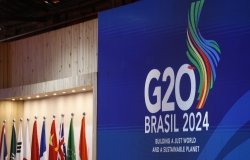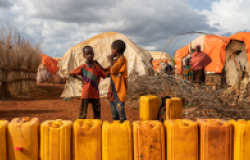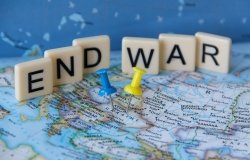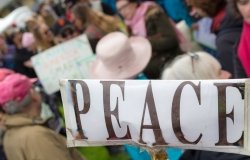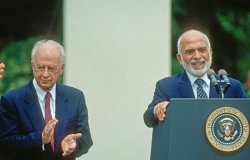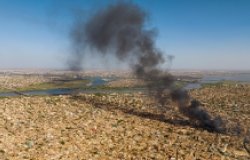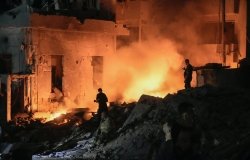Iran and the Bomb: Why the U.S. Can’t Ride the Iranian Tiger
"The Obama Administration believes it can use a nuclear agreement with Iran to ride and even domesticate the Persian tiger, harnessing its expansionist instincts to serve American interests. That’s not likely," writes Aaron David Miller.
In 2011, the so-called Arab spring showered much of the Arab world, and key Arab states in particular, with violence, trauma, barbarism, and sectarian conflict while cruelly reserving its greatest benefits for their Persian rivals.
Five years on, make no mistake: We are witnessing a Persian spring. And one that has little to do with the forces of internal political change or the democratization of Iran’s authoritarian regime. Instead, these winds of change may well strengthen the regime’s capacity to maintain political control and expand its regional reach and influence in ways no one could have anticipated.
The Obama Administration believes it can use a nuclear agreement with Iran to ride and even domesticate the Persian tiger, harnessing its expansionist instincts to serve American interests. That’s not likely. Here’s why:
Iran Is an Expansionist Power
Iran’s pragmatism must not be confused with its expansionist goals. Teheran is not a status quo power. The marriage of ideology, grandiosity, and insecurity that has long shaped Iran’s post-revolutionary self-image guarantees a dynamic and aggrandizing foreign policy and the need to maintain tight control at home. Iran seeks stability, but one that is geared to a distinctly Iranian vision of the region that differs fundamentally from America’s.
We should not conflate a temporary coincidence of interests, such as the need to make common cause against IS, with the fundamental differences between Teheran’s and Washington’s hopes for the Middle East. Iran’s regional vision means the following: an Iraq led by a relatively weak Shi‘a regime beholden to Iran; a Lebanon in which Hezbollah remains the most powerful actor always willing to confront Israel; a more stable Syria, perhaps without Assad and decentralized, but with a Shi‘a component open to Iran and not controlled by a U.S.- or Saudi-backed Sunni regime; an Arabian Peninsula where Iran, through Yemen and other Shi‘a allies, can keep the Saudis off balance; and a Persian Gulf where Iran, even though it would be constrained by a U.S. military presence, remains the dominant regional power.
Iran’s rise represents the most consequential development in the region since the U.S. wars in Afghanistan and Iraq. Indeed together with the Arab spring, they have facilitated the Persian spring. And Iran has achieved its spring under very difficult circumstances, including an increased U.S. military presence in the region and tough sanctions that have wrecked its economy. One can only imagine its capacity if Iran is freed from those constraints. To date, the U.S. has lacked both the staying power and the influence to thwart Iran’s reach. In pursuit of a nuclear deal that it believes will constrain Iran’s rise, Washington may well be enabling it further.
Iran Has Reliable Allies
Neither Teheran nor its allies are ten feet tall. Quite the contrary, its friends collectively represent some very weak tea. Indeed, there’s no doubt that supporting Bashar Assad is a real drain on Iran’s resources, but still key to its relationship with Lebanon’s Hizballah and to avoiding encirclement by Sunnis. And this friendship circle is linked together in a pretty enduring mutual dependency. To paraphrase American founder Benjamin Franklin, they must all hang together or most assuredly they will hang separately. This existential pact means that Iran has enormous influence over Hezbollah, the Assad regime, select Iraqi Shi‘a militias, and its own Revolutionary Guard units, which are the tip of the Iran’s regional spear in Syria and even in Yemen.
Outside the region, the Russians and the Chinese are prepared to back up Teheran in the UN Security Council and on the ground, as Moscow’s recent sale of the S-300 missile system to Iran attests. They do so largely for economic reasons, as well as to thwart any sort of Pax Americana. In a neighborhood of weak and dysfunctional Arab states, the power of allies is relative. And Iran’s rise is no small matter. Suffice it to say, Teheran has more control over its allies than the U.S. has over Saudi Arabia, the UAE, or Israel. Indeed, it’s the cruelest of ironies that Washington’s Iran-centric view of the region, largely driven by the nuclear issue, is perhaps most responsible for alienating these traditional friends.
Nuclear Deal: Koshering Iran
Blocking Iran’s path to a nuclear weapon is a critical U.S. foreign policy goal. And yet there’s a very good chance that a nuclear agreement, far from constraining Iran’s power and reach, will only extend them. Iran has played its putative nuclear card well, and it has done so without having to permanently discard it. It will use the billions in sanctions relief to coopt any public unrest, pay off Revolutionary Guards who have been benefitting from black market sanctions activity, and expand its influence in the region.
It is a cruel irony that the nuclear card that made Iran an outlier will now be used to gain its access back into the realm of respectability. The Russian sale of its S-300 surface to air missile system is only the first indication of how the nuclear deal will offer cover for many to pronounce Iran open for business again. What does it matter if Iran accepts restrictions on the nuclear issue if it can continue to expand in the region, this time without sanctions.
Transaction or Transformation?
The other view of the nuclear deal is that it offers Iran a way in from the cold and to international respectability. This view holds, in essence, that once freed from sanctions the Iranian public will become accustomed to the new normal—a better economy and a more integrated status in a globalized world. And over time, the mullahs will have no choice but to adjust their revolutionary impulses in the face of popular pressure for change. After all, much can happen within the span of a nuclear deal stretching out a decade and beyond. But authoritarian states don’t change quickly—and sometimes not at all—when it comes to letting go of real control. Indeed as Russia and China attest, you can open up economically and still maintain an iron grip at home and expand abroad.
More likely, in the service of an eminently reasonable and important goal—keeping Iran away from a nuke—the Obama Administration is now stuck with a policy that will likely allow Iran to expand its influence abroad and maintain its repressive policies home, all without undergoing any real sense that it has altered its expansionist or revolutionary designs. Indeed Teheran may well be better equipped now to pursue them and to ensure internal control when suspension of sanctions permits economic recovery.
The nuclear issue was always a symptom of a much more fundamental problem: Iran’s own view of itself as an expansionist Islamic great power, now the world’s greatest. The Obama administration may well avoid what could have been terrible a crisis over the nuclear issue. But in many ways it has just kicked the can down the road, alienating U.S. regional allies in the process. And what the next President may well find is that, far from riding the Iranian tiger, it is riding us. We may see a bigger, richer, stronger Iran that has more influence in the region, and one that, far from giving up its putative nuclear weapons aspirations, is as well positioned as ever to pursue them.
The opinions expressed here are solely those of the author.
This article was originally published in The American Interest.
About the Author


Middle East Program
The Wilson Center’s Middle East Program serves as a crucial resource for the policymaking community and beyond, providing analyses and research that helps inform US foreign policymaking, stimulates public debate, and expands knowledge about issues in the wider Middle East and North Africa (MENA) region. Read more
